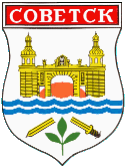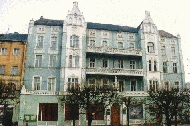|
SOVETSK.
DESCRIPTION.
Shortcuts:
Introduction
Location
Historical Background
Population and Demographic Situation
Sovetsk Today
Local Government System
Education and Culture
|
Introduction
Code OKATO: 27430
Year of establishment:
1288
Status of the city: 1552 г.
Renamed into Sovetsk: 1946
Telephone code:
01161
Time zone: Moscow time - 1 hr.
|

|
<top>
Location
Sovetsk is the city of oblast subordination, the second largest
in Kaliningrad oblast. It is located on the border with Lithuania
at the river Neman, 59 km away from the river's mouth, 123 km to
the northeast from Kaliningrad.
In the north Sovetsk borders Lithuania, in the southeast Nemansky
rayon of Kaliningrad oblast, in the northwest Slavsky rayon. Sovetsk
is 40 km away from Krasnoznamensk, center of the third largest rayon
of Kaliningrad oblast.
Sovetsk has a territory of 42 square km.
The city is a critical transportation hub of the region. It is
situated on the major crossroads connecting Russia and Western Europe
and has a railway, port and highway infrastructure.
<top>
Historical
Background
Established in 1552, the city (former Tilsit)
used to be one of the largest in eastern Prussia, performing significant
trade, cultural, administrative and military functions. The settlement
Tilsit (located in the territory of modern city Sovetsk) was first
mentioned in the chronicles in 1276. Historically, this territory
had been occupied by the Prussians, nationality of the Baltic group.
At the beginning of the 13th century, the land was conquered by
the Teutonic Knights. Later on, during 1230-1289, it became a full
possession of the Teutonic Order and was invaded by the German colonists.
By the end of 19th century Germans accounted for 70% of the total
population. In early 20th century all national communities except
for Old Believers, assimilate with Germans.
Tilsit had received a world recognition becoming the place where
historical negotiations between Napoleon the First, Frederick Wilgielm
and Alexander the First were conducted in 1807 and the Tilsit Peace
treaty was signed there.
In the 19th century the history of the city was characterized by
its rapid development: numerous civil, industrial, military and
technical engineering projects, were constructed there, most of
them survived but were rebuilt later.
From the foundation time and until now, due to its proximity to
the border, Tilsit-Sovetsk has always been a place for concentration
of troops and therefore there is a great number of quarters and
other military constructions in the city.
At the end of the World War II the city suffered damage from the
battle operations. Practically all buildings along the river Neman
were destroyed. When the World War II was over, Tilsit being a part
of former eastern Prussia joined Russia under the decision of Berlin
(Potsdam) conference of 1945. In 1946 Tilsit was renamed into Sovetsk.
<top>
Population and Demographic Situation
The city has a population of 43,7 thousand people. The population
has undergone little changes during the last decade. If earlier
its growth was caused by a mechanical increase (500 persons annually),
recently such growth has stopped while the natural growth is characterized
by negative parameters.
The city has a population of 43,7 thousand people, including 20,5
thousand men and 23,2 thousand women, among them:
|
Children under the age of 17
People over the age of 17 and under 40
People over the age of 40 and under 55
People over 55
y.o. |
8385
13727
10448
11140 |
33.9 thousand people are capable to work. The city is remote from
so called "hot spots" and has one homogeneous population
of Russians, which guarantees stable situation without national
and ethnic conflicts.
Employed population is 14.7 thousand people, including 5.9 thousand
people employed at the industry.
Ethnic composition in the region has been rather stable over the
last ten years. Russians predominate (34 185), followed by
|
Lithuanians
Ukrainians
Belorussians
Poles
And others |
2 280
2 537
2 365
172
2 161 |
Employed population is 14.7 thousand people, including:
|
Industry
Agriculture
Budget sphere
Other sectors (commerce, communication,
transport, construction, etc.)
Entrepreneurs |
4.3 thousand,
0.1 thousand,
3.4 thousand,
5.3 thousand,
2.8 thousand people |
Pensioners amount to 13186 thousand people, children under the age
of 15 -6897 people, children over the age of 15 and students of
educational institutions - 1216 people. Unemployment (01.01.2000)
- 288 persons, 1.5% out of the economically active population.
<top>
Sovetsk
Today
The city has a status of independent municipal institution.
At present the city has multifunctional economic base, developed
social and cultural sphere (high educational institutions, hospitals,
theatre, administrative institutions), frontier passage to one of
the key economic partners - Lithuania - and is being a transport
junction (railway station, river port, automobile and railway bridges
across Neman). City institutions are attended not only by the residents
of the city but also by people from nearby regions of Kaliningrad
and Lithuania.
|
Sovetsk is a stunning combination
of new and old architectural styles. Great efforts have been
put to restore the old buildings. At the same time many new
buildings like shops and cafes have decorated the downtown
of Sovetsk, making the appearance of the old streets more
modern and colorful.
|
 |
Kaliningrad oblast has a status of the
Special Economic Zone, the fact makes Sovetsk an attractive city
for foreign investors. There are 13 foreign companies and 17 joint
ventures in the city.
<top>
Local
Government
The city administration system comprises the following elements:
-
City Board of deputies ;
-
City administration;
-
Mayor;
-
Chairman of the City Board of deputies;
- Territorial and other government bodies acting in accordance
with the Charter of municipal institution.
The
local government system is based on three traditionally strong elements:
- City council
- City administration
- Mayor
The Charter of the City defines the powers delegated to them
by the city population.
Mayor is a supreme decision-maker in the local self-government
system and is elected by the citizens every forth year. The Mayor
has individual overall responsibility for performing functions of
executive authority. He independently appoints city administration
officials according to the administrative structure approved by
the City Council. He also has the right to appoint/discharge directors
of municipal enterprises and institutions. Within the limits of
his authority defined by the Charter of the City, the Mayor gives
orders and promulgates resolutions. The activities of the Mayor
are accountable to the city population and City Council.
City Council is a representative body of local self-government.
The City Council consists of 21 deputies elected by the population
for the period of 4 years. The City Council is headed by a chairman,
a full-time professional politician elected among the City Council
deputies for the same period. The City Council passes joint resolutions
on local issues.
City administration carries out assignments on behalf of the Mayor.
The administration officials are appointed and discharged by the
Mayor.
In order to meet the expectations of the population, municipal
management has three priority sectors:
-
Social sphere;
-
Financial and economic issues;
-
Municipal economy.
Contact Information
|
Head
of Sovetsk
Svetlov Vjacheslav
Nikolaevich
3, Tetralnaja
238750 Sovetsk, Kaliningrad oblast, Russia
tel: (01161) 72477
fax: (01161) 72035
E-mail: admsov@baltnet.ru
|
 |
<top>
Education
and Culture
|

|
Sovetsk has unique cultural and historical monuments totaling
over 166, including magnificent entrance arch of the Queen
Louisa bridge across Neman river. The bridge was built in
1907 to commemorate 100 years anniversary of Tilsit Peace
Treaty. Nowadays the arch is a symbol of the city and is depicted
on the City's Emblem.
|
Sovetsk plays an important social-cultural role of regional significance.
In the city there are 9 secondary schools (5 144 persons), evening
secondary school (153 persons), boarding school (260 persons), orphanage
(31 persons), shelter for children, 13 kindergartens (1 206 persons)
including 11 municipal (1066 persons), 2 vocational-training colleges
(800 students), 2 professional lyceums (896 students), cinema college
(647 students). In the city there are also branches of Saint-Petersburg
University of Culture (120 students), Saint-Petersburg State University
of Service and Economics (249 persons), Moscow New Law Institute
(100 persons), North-West Correspondence Polytechnic Institute of
Saint-Petersburg (100 persons).
The following healthcare institutions are situated in the city:
city hospital#1 for 160 beds, city hospital #2 for 80 beds, city
hospital#3 for 50 beds, children's hospital for 40 beds, TB-hospital
for 80 beds, maternity hospital for 60 beds, dentistry, psychoneurological
hospital for children for 75 beds. Besides, in the city there is
a regional sanatorium.
As for the institutions of culture and art, they are the following:
children's musical school for 640 students, children's art school
for 200 persons, Leisure center "Parus", city libraries
for youth and children of total area 2 120 m2 with 19 916 registered
readers, Culture Palace (auditorium for 800 seats), House of Offices
(auditorium for 400 seats), "Molodezhny" theater (300
seats), city history museum (area 475 m2), Kaliningrad regional
college of culture and art -780 students, Creativity Center for
children and youth (departments: technical, tourist, art, nature,
applied).
The following institutions provide educational services:
1.
Three state institutions of elementary professional education,
including:
1)
Lyceum #14 - trains specialists for light industry (clothing
manufacture) and consumer services;
2)
Lyceum #12 - rains qualified specialists for industry,
trade, and catering;
3)
College #1 - trains motor mechanics, electricians, metalworkers,
turners, etc.
2. Two
institutions of secondary vocational education, including:
1)
Technical School of Television (with specialties: audiovisual
equipment, economy, bookkeeping);
2)
Oblast College of Culture and Arts.
3.
Five branch institutes:
1)
Saint Petersburg University of culture
2)
Saint Petersburg State University of Economy and Service
3)
Moscow Institute of Law
4)
Northwestern Correspondence Polytechnical Institute
5)
Saint Petersburg State University of Television.
<top>
|

